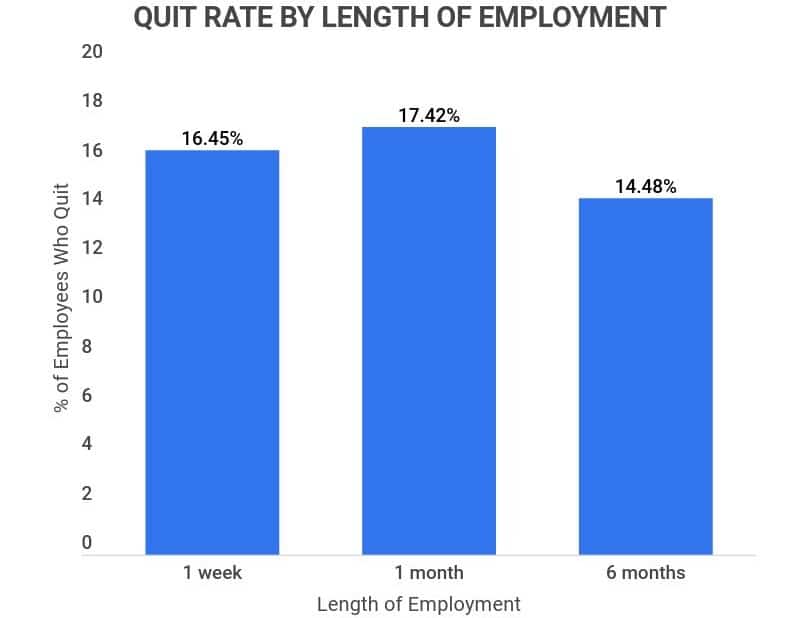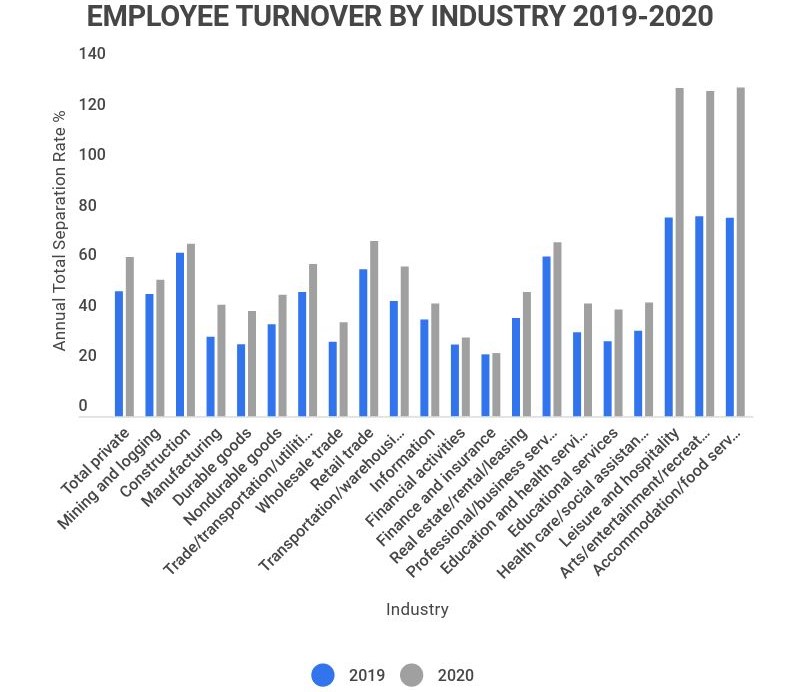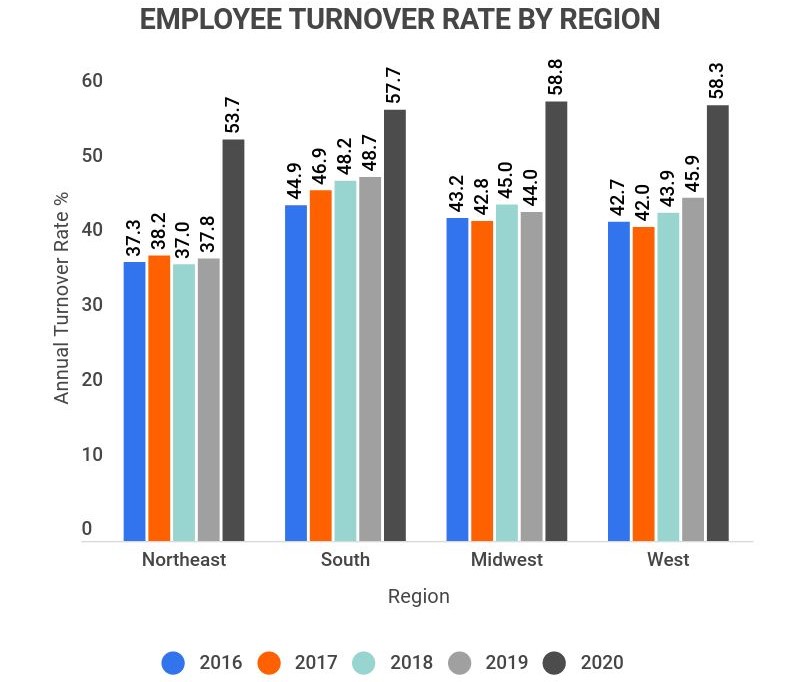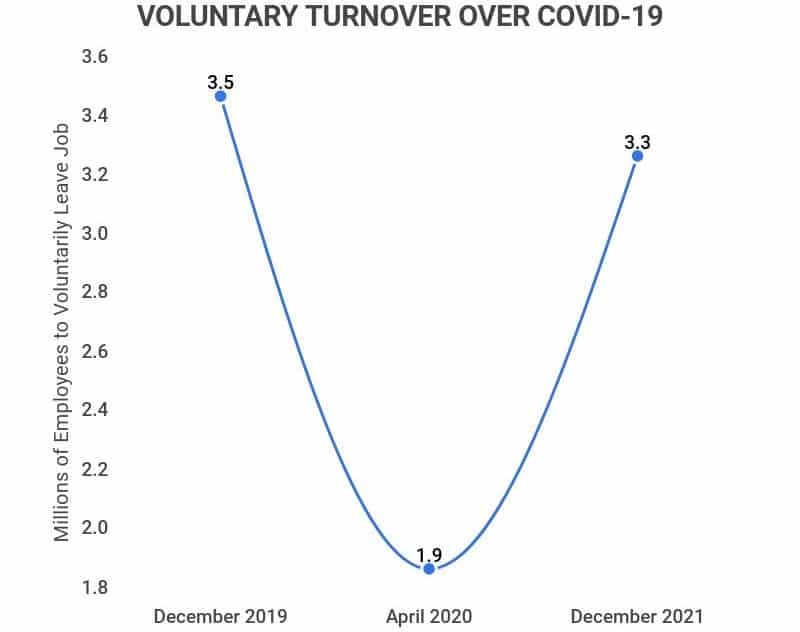- HR Statistics
- Average Labor Cost Percent Of Sales
- Average Time to Reach Profitability At A Startup
- Office Space Per Employee
- Recruitment Statistics
- Employee Engagement Statistics
- Work-Life Balance Statistics
- BYOD Statistics
- Paternity Leave Statistics
- Onboarding Statistics
- Average Paid Maternity Leave In Us
- Average Cost Of A Bad Hire
- Employee Theft Statistics
- Paid Family Leave Statistics
- Cost Of Hiring Statistics
- Employee Turnover Statistics
- Average Cost Of Employer Sponsored Health Insurance Statistics
- Sexual Harassment In The Workplace Statistics
- HR Statistics
- PTO Statistics
- Social Media Recruitment Statistics
- Hiring Statistics
- Out Of Prison Employment Statistics
Research Summary. For many companies, employee turnover is a highly expensive issue. With that in mind, our research team set out to determine the reasons for employee turnover, its influence on organizations, and trends in turnover over the past couple of years. According to our extensive research:
-
As of 2021, the national average annual turnover rate was 47.2%.
-
The number of people who left their job due to quitting, layoffs, discharges, or any other separation increased to 5.9 million people in December.
-
Companies lose 18% of their workforce to turnover each year, on average. 12% of this is voluntary, and 6% is involuntary (layoffs, terminations, etc.).
-
In 2022, the overall cost of voluntary employee turnover amounted to over $1 trillion.
-
Highly engaged employees are 87% less likely to leave.
-
31% of employees have quit within the first 6 months of starting a new job.
For further analysis, we broke down the data in the following ways:
Industry | Region | Trends | Reasons | Effects

General Employee Turnover Statistics:
-
Approximately 60-70% of all turnover is voluntary.
According to a study conducted by the ADP Research Institute from 2015-2016, the majority of industries fall into this turnover percentage range. Since voluntary turnover occurs as a result of an employee’s decision, it is much more difficult to predict.
-
33% of surveyed employees quit their job within the first 90 days that they’re employed.
According to a survey of 1,500 workers in the United States done by a recruiting firm in 2018, nearly 500 individuals stated that they had quit their job within the first three months of employment.
Of the 33% who left their jobs within the first 90 days, nearly half stated that they quit because the position didn’t align with the expectations built during the interviewing phase.
-
As of December, there are 11 million job openings in the United States.
This number has remained failry steady over the course of 2022 and represents an enormous addition of 4.1 million new job openings since December 2020.
-
17.42% of employees who quit their job will do it within their first month of employment.
Alternatively, 16.45% of people quit their job within their first week of employment, and 14.48% of employees who quit do it after six months.

Employee Turnover Statistics by Industry
| Industry | 2017 | 2018 | 2019 | 2020 | 2021 |
|---|---|---|---|---|---|
| Total | 43% | 44% | 45% | 57% | 47% |
| Total private | 47% | 49% | 49% | 63% | 52% |
| Mining and logging | 48% | 54% | 48% | 54% | 36% |
| Construction | 61% | 57% | 65% | 68% | 57% |
| Manufacturing | 30% | 32% | 31% | 44% | 40% |
| Durable goods | 27% | 28% | 28% | 41% | 35% |
| Nondurable goods | 36% | 38% | 36% | 48% | 47% |
| Trade, transportation, and utilities | 45% | 48% | 49% | 60% | 55% |
| Wholesale trade | 27% | 29% | 29% | 37% | 34% |
| Retail trade | 53% | 58% | 58% | 69% | 65% |
| Transportation, warehousing, and utilities | 40% | 44% | 45% | 59% | 49% |
| Information | 35% | 37% | 38% | 44% | 39% |
| Financial activities | 28% | 27% | 28% | 31% | 29% |
| Finance and insurance | 25% | 24% | 24% | 25% | 26% |
| Real estate and rental and leasing | 37% | 35% | 39% | 49% | 35% |
| Professional and business services | 63% | 63% | 63% | 69% | 64% |
| Education and health services | 32% | 34% | 33% | 44% | 37% |
| Educational services | 29% | 30% | 29% | 42% | 26% |
| Health care and social assistance | 33% | 34% | 34% | 45% | 39% |
| Leisure and hospitality | 74% | 77% | 79% | 130% | 85% |
| Arts, entertainment, and recreation | 84% | 88% | 79% | 129% | 76% |
| Accommodation and food services | 72% | 75% | 78% | 130% | 86% |
| Other services | 45% | 44% | 43% | 67% | 72% |
| Government | 18% | 18% | 18% | 24% | 18% |
-
For employee turnover rates by industry in 2021, the industry with the highest rate is in accommodation and food service at 86% .
Other fields that had extremely high rates of staff turnover in 2020 include the arts and entertainment industry with 76%, retail trade with 65%, and construction with 57%.
-
For employee turnover rates by industry in 2021, the industry with the lowest rate is the government sector at 18%.
Industries that also had quite low rates of employee turnover in 2021 include wholesale trade with 34% and finance and insurance with 26%.
-
The field of education and health services has an average rate of turnover at 37% in 2021.
Additionally, the real estate and rental industry had a standard turnover rate of 35%, and the manufacturing turnover rate in 2021 was 40%.
-
The average employee retention rate by industry in 2021 can calculated by subtracting the turnover rates by industry in 2021. For example, the retention rate for manufacturing in 2021 is at 60%.

Employee Turnover Regional Statistics
| Region | 2017 | 2018 | 2019 | 2020 | 2021 |
|---|---|---|---|---|---|
| Northeast | 38% | 37% | 37% | 53% | 39% |
| South | 46% | 48% | 48% | 57% | 52% |
| Midwest | 42% | 45% | 44% | 58% | 48% |
| West | 42% | 43% | 45% | 58% | 45% |
-
The American region that has the highest rate of turnover as of 2021 was the South with 52%
-
The American region that has the lowest rate of turnover as of 2021 is the Northeast, with 39%.

Employee Turnover Statistics Trends and Predictions
-
The employee turnover rate in the United States decreased from 56.8% in 2020 to 47.2% in 2021.
Though there was a record-breaking low in American employee turnover in 2016, that rate skyrocketed to over a full 50% by 2020. In the following year, however the number has seen a decline.
-
4.1 million people quit their jobs in December 2022.
That’s 100,000 less than the previous month, with transportation, warehousing, and utilities as the industry to see the biggest change from the previous month.
-
The number of people quitting their jobs remains at a rate of 2.7% as of December 2021.
Quitting made up 70% of all job separations in April of 2021. This was the highest rate of employees quitting their jobs in the United States since the collation of this type of information started by the Bureau of Labor Statistics. Comparatively, in April of 2020, quitting only accounted for 17.25% of the total job separations in the United States.
-
The number of voluntary turnovers dropped to 1.9 million monthly during the pandemic (April 2020).
Right before the pandemic started, approximately 3.5 million people were leaving their jobs every month. When the COVID-19 pandemic began, there was a significant drop in the number of voluntary turnovers. It is predicted that by December of 2021, the rate of turnover will increase again to 3.3 million people leaving their jobs voluntarily.

Reasons for High Employee Turnover and Retention Rates
-
The most common reason that people leave their jobs is money.
Besides wanting to earn more, other common reasons that good employees end up quitting their job are frustrating coworkers or unhelpful management.
-
58% of employees would consider changing jobs for increased pay transparency.
When considering how many individuals from Gen-Z feel this way, the percentage jumps up to 70%. This suggests that employees greatly value payment transparency, and having it at a company can increase their retention rates.
-
40% of office employees plan on leaving their job within the next year due to their company’s handling of the pandemic.
According to a survey of 1,500 office workers and C-level executives, approximately two out of every five employees are planning to resign, alluding to growing disillusionment among employees.
-
70% of employees do not feel engaged or connected at work.
The 2017 Gallup ‘State of the American Workplace’ survey stated that a mere 30% of workers feel engaged and connected to their job. Based on other statistics involving employee satisfaction at work in recent years, it’s likely that the percentage of disengaged employees has skyrocketed further, too.
-
The top contributors to a high employee retention rate are a flexible work environment, adequate compensation, and recognition for achievements.
Other qualities that have been known to keep employees around for the long haul are useful benefits, providing opportunities for career growth, and maintaining a proper work-life balance.
-
In organizations with a high turnover rate, an improvement in employee engagement also achieved 24% less turnover.
Alternatively, in businesses that initially had a low rate of turnover, improving engagement led to 59% less turnover than usual. An improvement in employee engagement also decreased absenteeism by 41% and produced a 17% increase in productivity.
-
Organizations with a strong onboarding process retain 91% of their first-year workers.
While most companies likely believe that their onboarding process is flawless, it’s likely that this isn’t the case. In fact, only 12% of employees believe that their employer did an outstanding job with the onboarding process.
-
56.9% of employees are satisfied with their jobs as of 2020, the highest rate of job satisfaction in 20 years.
Effects of Employee Turnover
-
The average cost to replace a salaried employee is six to nine months of their salary.
For example, an employee who receives a salary of $60,000 annually would cost an estimated $30,000-$45,000 to replace. This figure would increase the more an employee makes. This includes the cost of hiring, onboarding, lost productivity, and errors.
-
As of 2021, 92% of Human Resources leaders state that their top priority is employee experience.
In a recent survey of 500 HR leaders, the vast majority believe that their top priority for improving retention should be the employee experience. It’s becoming more apparent in recent years that the satisfaction of employees drives a company’s success.
-
A business with 100 people that are providing an average salary of $50,000 could have turnover costs of between $660,000 to $2.6 million every year.
According to Gallup, that equates to a trillion dollars per year in the United States that is being lost to employee turnover.
Employee Turnover FAQ
-
Employee turnover is defined as the number of employees that leave a company for any reason over a specified amount of time. The turnover metaphor is used to describe the exiting of one employee to be replaced by another.
Employee turnover is of importance to companies because it is extremely expensive to replace trained staff. From the hiring process to onboarding, it can cost an organization upwards of $40,000 to replace a staff member who makes an average salary.
Alternatively, a company’s retention rate describes how many employees stay with them over a given period of time. A high rate of retention is positive, but a high rate of turnover is negative for a company.
-
What are the different types of employee turnover?
The different types of employee turnover are healthy turnover, regrettable turnover, and avoidable turnover. All of these types of employee turnover can impact a business in different ways. Firstly, there is voluntary versus involuntary turnover.
As the name suggests, voluntary turnover is when the employee decides to leave their job through quitting or retirement. Alternatively, involuntary turnover is when the employer steps in and severs the employment relationship through firing for bad performance or layoffs.
Other terms that are used to describe employee turnover are the sub-genres of being healthy, regrettable, and avoidable.
-
Healthy turnover: When an employee’s departure from a company is the best choice for all parties involved.
-
Regrettable turnover: When a company loses a high-performing employee, which would’ve been better to keep.
-
Avoidable turnover: When an employee leaves a company for a reason that the employee could’ve prevented.
-
-
How long does it take for an employee to be fully productive?
It takes approximately eight months for an employee to reach their full productivity after being newly hired. That’s a long amount of time considering that almost 33% of employees are looking for a new job within their first six months of employment.
That means over a quarter of employees are looking for their next opportunity before becoming fully productive in their current position.
-
Who is responsible for a company’s employee turnover?
Usually, management is responsible for employee turnover. Of course there are many potential factors, but management is always a great way to start. One of the most frequently cited reasons for employees leaving their job is poor management or a hostile work environment due to management style.
The responsibility for employee turnover can also fall on the shoulders of senior management or human resources professionals.
Conclusion
The employee turnover and retention rate of a company will have a huge impact on its long-term success. While many consider the loss of employees as an inevitable part of business, organizations lose millions every year in the time and the collective effort it takes to hire and train new employees.
It’s estimated that United States businesses spend one trillion dollars yearly on the costs of employee turnover. Additionally, the rate of turnover has risen a massive 12.2% since before the COVID-19 pandemic.
There are quite a few reasons why a company’s staff turnover might be high, but the most common reason is a lack of opportunities for employees. The satisfaction and engagement of an organization’s employees end up driving their productivity, and unfortunately, it lacks in many places of employment.
Only 30% of employees feel engaged with their job, which eventually leads to a greater rate of turnover. The cost of replacing an unsatisfied employee who makes $50,000 yearly would average $30,000-$45,000, and that’s only the price for replacing one position.
Overall, Human Resources leaders agree that employee satisfaction and retention are crucial. As of 2021, 92% of HR leaders consider the employee experience to be their main priority. Hopefully, this drive to improve the employee experience because otherwise, the rate of turnover will continue to increase.
References
-
BLS. “Annual total separations rates by industry and region, not seasonally adjusted”. Accessed on August 23, 2021
-
BLS. “JOB OPENINGS AND LABOR TURNOVER – JUNE 2021”. Accessed on August 23, 2021
-
Conference Board. “Job Satisfaction 2021: Job satisfaction remains high even in the midst of the pandemic and economic chaos”. Accessed on August 23, 2021
-
Catalyst. “Turnover and Retention (Quick Take).” Accessed on August 23, 2021
-
ADP. “Revelations From Workforce Turnover A Closer Look Through Predictive Analytics.” Accessed on August 23, 2021
-
Psychology Today. “Why 33 Percent of New Employees Quit in 90 Days”. Accessed on August 23, 2021
-
Vultus. “Why do 33% of the new hires quit within six months?”. Accessed on August 23, 2021
-
Yahoo Finance. “A Record 3.8 Million Workers Quit Their Jobs in April 2021: Who Are They?”. Accessed on August 23, 2021
-
SHRM. “Turnover ‘Tsunami’ Expected Once Pandemic Ends.” Accessed on August 23, 2021Accessed on August 23, 2021
-
Zippia. “SURVEY: WHY DO PEOPLE QUIT THEIR JOBS?” Accessed on August 23, 2021
-
INC. “New Report: Pay Transparency May Be the Key to Keeping Your Employees in 2021”. Accessed on August 23, 2021
-
Business Wire. “2 out of 5 Office Workers Plan to Resign Based on How Their Company Handled the Pandemic, SilkRoad Technology and OnePoll Survey Reveals”. Accessed on August 23, 2021
-
INC. “How to Tell If Employees Really Feel Connected and Engaged.” Accessed on August 23, 2021
-
Rise. “8 essential employee retention factors modern employers ignore”. Accessed on August 23, 2021
-
Gallup. “The Right Culture: Not Just About Employee Satisfaction.” Accessed on August 23, 2021
-
Hireology. “How Your Onboarding Process Affects Employee Retention.” Accessed on August 23, 2021
-
USI. “Cost of employee turnover”..Accessed on August 23, 2021
-
Forbes. “92% Of HR Leaders Set Employee Experience As Top Priority In 2021”. Accessed on August 23, 2021
-
Gallup. “This Fixable Problem Costs U.S. Businesses $1 Trillion”. Accessed on August 23, 2021
-
Harvard Business Review. “Technology Can Save Onboarding from Itself.” Accessed on August 23, 2021
- HR Statistics
- Average Labor Cost Percent Of Sales
- Average Time to Reach Profitability At A Startup
- Office Space Per Employee
- Recruitment Statistics
- Employee Engagement Statistics
- Work-Life Balance Statistics
- BYOD Statistics
- Paternity Leave Statistics
- Onboarding Statistics
- Average Paid Maternity Leave In Us
- Average Cost Of A Bad Hire
- Employee Theft Statistics
- Paid Family Leave Statistics
- Cost Of Hiring Statistics
- Employee Turnover Statistics
- Average Cost Of Employer Sponsored Health Insurance Statistics
- Sexual Harassment In The Workplace Statistics
- HR Statistics
- PTO Statistics
- Social Media Recruitment Statistics
- Hiring Statistics
- Out Of Prison Employment Statistics






